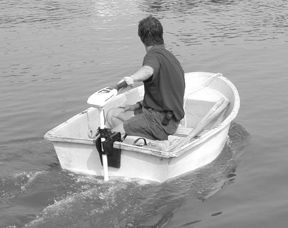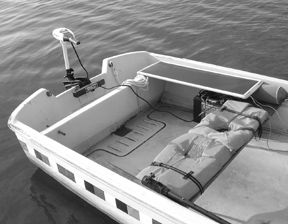
We’ll spare you the whole sordid history of our life with outboard engines, but if you heard it, you would agree that we’ve had more than our share of pain and sorrow. Let’s just say that once we had a fine, strong Johnson. It performed magnificently for 20 years. We eventually replaced it with a newer Johnson, for no other reason than that it was newer and shinier. Oh fie, fie upon it. It’s been downhill ever since.
The current outboard on our ancient Boston Whaler workboat is a 15-hp, four-stroke Evinrude, pull-started, tiller-steered, with a block made by Suzuki. It’s a lovely engine when it happens to be running, and if you don’t touch anything on it but the tiller and the gearshift. Unfortunately, it was made about four years ago, in the waning days of OMC’s ownership of that revered engine line. (Johnson and Evinrude are now owned by Bombardier of Canada.) We’re not sure what was happening in the design office and factory back then, but let’s just say that tolerances of every sort appear to us to have been rather lax.
Recently, the engine crapped out beyond our limits of skill and patience. We took it to the shop, thinking that we really didn’t want to see the %^(#@* survive the operation, and that outboards ain’t nothin’ but a heartache.
The workboat is used for a variety of tasks—taking marine gear out on the water for testing, for example. On its topsides are the remains of a recent paint test. But most of its life is spent ferrying people and gear from shore to bigger boats and back again.
We got thinking about lighter, simpler, cheaper engines. The Evinrude 15 weighs about 100 pounds, which is as much weight as anyone should want to wrestle on a writhing transom. Replacing it with the current Johnson equivalent would be about $2,000. Downsizing a bit to, say, a Mercury 8-hp two-stroke, would mean having an engine much easier to wrestle, and it would push the Whaler around adequately for our purposes. But it would still cost around $1,500 and need fuel, maintenance, and, in our case, regularly scheduled exorcism.
Then it occurred to us that our outboard habits probably reflect those of a fair number of readers—people who use their dinghies mostly to travel from dock to boat and back again, or from an anchored boat to shore-side amenities in cruising harbors, or for quiet sunset tours of those harbors.
So, awaiting the Evinrude’s prognosis, we undertook an experiment. We bought a Minn-Kota trolling motor, “Riptide” model RT55/S (55 lbs. of thrust) made to be used in salt water. We first put it on a logical vessel, a small rowing dinghy (weight approximately 70 lbs.) with a dual-purpose 12-volt battery of uncertain amp-hour rating, and ran the round-trip between dock and big boat—a bit over half a nautical mile each way. The dinghy ran forth and back at about four knots, certainly faster than we could row the distance. The battery gave out toward the end, and the terminals were hot. But it worked. And it was quiet.

We then moved the Minn-Kota over to the transom of the Whaler (weight approximately 400 lbs.), with a 90-Ah West Marine (Deka) deep-cycle battery for power, and a 15-watt solar panel (with charge-controller) for daylight replenishment, and made the same trip. The Whaler ran at 2.8 knots. The one-way trip, which takes about 4 minutes with the 15-hp engine (counting the slow-zone in the harbor), took 12 minutes. But they were very pleasant minutes. We were guardedly hooked.
For several weeks we’ve been moving the motor between the Whaler and the dinghy. That’s no hardship—the motor weighs only about 22 pounds. Sometimes, though, we have to lug a battery (we keep one charged in the workshop in case the sun hasn’t been doing its job), and that’s less pleasant.
There are some worries. First, although we’ve successfully run the motor through a 15-knot headwind and foul current, there will certainly come a time when an oar-powered assist will be necessary. Second, we don’t know how it will hold up in the long run. We talked with a Minn-Kota technical representative about our use of the motor, and she told us that the company doesn’t test its trolling motors for running at 100% power for long periods of time. She said that one customer, who runs the motors almost continuously on bumper boats at an amusement park, burns through quite a few brushes. She said that 12 minutes at 100-percent thrust, with a proper cool-down period afterward, didn’t sound unreasonable, but she wasn’t sure whether it might constitute “misuse” under the terms of the otherwise generous three-year warranty.
In any case, we now run our motor at 50 to 75 percent of its 45-amp max power most of the time, because the slight loss of speed makes little difference when you’re just ghosting along anyway, and it saves a lot of battery energy. Remember, there’s a pronounced discharge-rate curve for deep-cycle batteries. A 100-Ah battery that’s rated for a 5-amp discharge over 20 hours may not even last an hour if you demand 45 amps from it the whole time, whereas it should give you more like two hours if you run it at 25 amps. Even then, some say you should use only about a third of the rated amp-hours in a battery, in order to keep discharge/charge levels at their healthiest for a long battery life.
Third, the transom bracket, while nicely designed and easy to manage, is mostly black plastic, and seems delicate. We wonder how it will stand up in the long run.
Here’s our take on the system so far. On the Whaler, we do miss the reserve speed and power of the gasoline engine, even though most of the time that speed and power is unused. We’re wary of that bad-weather or big-hurry day when the trolling motor will reveal itself as just a silly idea. However, in these halcyon days we’ve learned to take a deep breath and enjoy the slow, smooth, quiet ride. No fumes, no fuel tank in the boat, no visits to the gas dock, no wrestling with cast-iron brutes. No pull-cord starting—just twist the throttle and it goes forward. Twist the other way and it reverses. Center the throttle and everything stops.

For dinghy propulsion, if we can make this motor last a few years in the light-duty circumstances described above, we won’t be going back to internal combustion. It’ll be strictly amps, oars, and solar power.
There’s virtually zero maintenance. The motor gets rinsed with fresh water and occasionally wiped down with Armoral®. (We just let the rain rinse ours—no coddling.) There’s a propeller zinc that should be changed “after 2000 hours of run time or 1.5 seasons, whichever comes first.”
This system obviously won’t work for everyone, but we suspect it might serve many who just haven’t considered it yet.
We’ll report again on how the Minn-Kota holds up, and would very much like to hear opinions from readers who have experience using trolling motors for propulsion.
Contact – Minn-Kota, 800/227-6433, www.minnkotamotors.com.
Also With This Article
“Minn-Kota Model RT 55/S Specs”





































Any update on this? Would love to know how this held up over time.
I would also love to hear an update.